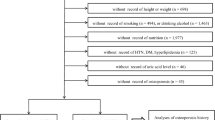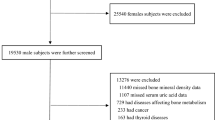Abstract
Recent evidence shows that uric acid is protective against some neurological diseases, but can be detrimental in many metabolic and cardiovascular disorders. In this study, we examined the association between serum uric acid levels and bone metabolism in Chinese males and postmenopausal females. A total of 943 males and 4256 postmenopausal females were recruited in Shanghai. The levels of serum uric acid and bone turnover markers (BTMs) were detected along with other biochemical traits. In addition, the fat distribution was calculated through MRI and image analysis software, and bone mineral density (BMD) was determined using dual-energy X-ray absorptiometry. For postmenopausal females, the prevalence of osteoporosis was significantly lower in the hyperuricemia group compared with the normouricemic group (P=4.65E-06). In females, serum uric acid level was significantly associated with osteoporosis, with odds ratio (OR) and 95% confidence interval (95% CI) of 0.844 [0.763; 0.933] (P=0.0009) after adjusting for age, body mass index, HbA1c, lean mass, visceral and subcutaneous fat areas, albumin, 25-hydroxyvitamin D3 [25(OH)D3], and parathyroid hormone (PTH). In females, serum uric acid level was positively correlated with the BMD of the femoral neck (β±SE: 0.0463±0.0161; P=0.0042), total hip (β±SE: 0.0433±0.0149; P=0.0038) and L1-4 (β±SE: 0.0628±0.0165; P=0.0001) after further adjusting for age, BMI, HbA1c, lean mass, VFA, SFA, albumin, 25(OH)D3 and PTH. Regarding BTMs, serum uric acid level was negatively correlated with N-terminal procollagen of type I collagen (PINP) in females (β±SE: -0.1311±0.0508; P=0.0100). In summary, our results suggest that uric acid has a protective effect on bone metabolism independent of body composition in Chinese postmenopausal females.
Similar content being viewed by others
Log in or create a free account to read this content
Gain free access to this article, as well as selected content from this journal and more on nature.com
or
References
Wang Y, Tao Y, Hyman ME, Li J, Chen Y . Osteoporosis in china. Osteoporos Int 2009; 20: 1651–62.
Qu B, Ma Y, Yan M, Wu HH, Fan L, Liao DF, et al. The economic burden of fracture patients with osteoporosis in western China. Osteoporos Int 2014; 25: 1853–60.
Bowman GL, Shannon J, Frei B, Kaye JA, Quinn JF . Uric acid as a CNS antioxidant. J Alzheimers Dis 2010; 19: 1331–6.
Wang T, Bi Y, Xu M, Huang Y, Xu Y, Li X, et al. Serum uric acid associates with the incidence of type 2 diabetes in a prospective cohort of middle-aged and elderly Chinese. Endocrine 2011; 40: 109–16.
Yan D, Wang J, Jiang F, Zhang R, Wang T, Wang S, et al. A causal relationship between uric acid and diabetic macrovascular disease in Chinese type 2 diabetes patients: A Mendelian randomization analysis. Int J Cardiol 2016; 214: 194–9.
Sautin YY, Johnson RJ . Uric acid: the oxidant-antioxidant paradox. Nucleosides Nucleotides Nucleic Acids 2008; 27: 608–19.
Hardy R, Cooper MS . Bone loss in inflammatory disorders. J Endocrinol 2009; 201: 309–20.
Maggio D, Barabani M, Pierandrei M, Polidori MC, Catani M, Mecocci P, et al. Marked decrease in plasma antioxidants in aged osteoporotic women: results of a cross-sectional study. J Clin Endocrinol Metab 2003; 88: 1523–7.
Nabipour I, Sambrook PN, Blyth FM, Janu MR, Waite LM, Naganathan V, et al. Serum uric acid is associated with bone health in older men: a cross-sectional population-based study. J Bone Miner Res 2011; 26: 955–64.
Kim BJ, Baek S, Ahn SH, Kim SH, Jo MW, Bae SJ, et al. Higher serum uric acid as a protective factor against incident osteoporotic fractures in Korean men: a longitudinal study using the National Claim Registry. Osteoporos Int 2014; 25: 1837–44.
Ishizaka Y, Yamakado M, Toda A, Tani M, Ishizaka N . Relationship between serum uric acid and serum oxidative stress markers in the japanese general population. Nephron Clin Pract 2014; 128: 49–56.
Zhang D, Bobulescu IA, Maalouf NM, Adams-Huet B, Poindexter J, Park S, et al. Relationship between serum uric acid and bone mineral density in the general population and in rats with experimental hyperuricemia. J Bone Miner Res 2015; 30: 992–9.
Kim SC, Paik JM, Liu J, Curhan GC, Solomon DH . Gout and the risk of non-vertebral fracture. J Bone Miner Res 2017; 32: 230–6.
Cabral HW, Andolphi BF, Ferreira BV, Alves DC, Morelato RL . Chambo A Filho, et al. The use of biomarkers in clinical osteoporosis. Rev Assoc Med Bras (1992) 2016; 62: 368–76.
Sumino H, Ichikawa S, Kanda T, Nakamura T, Sakamaki T . Reduction of serum uric acid by hormone replacement therapy in postmenopausal women with hyperuricaemia. Lancet 1999; 354: 650.
Bonora E, Targher G, Zenere MB, Saggiani F, Cacciatori V, Tosi F, et al. Relationship of uric acid concentration to cardiovascular risk factors in young men. Role of obesity and central fat distribution. The Verona Young Men Atherosclerosis Risk Factors Study. Int J Obes Relat Metab Disord 1996; 20: 975–80.
Khosla S, Oursler MJ, Monroe DG . Estrogen and the skeleton. Trends Endocrinol Metab 2012; 23: 576–81.
Reid IR . Relationships between fat and bone. Osteoporos Int 2008; 19: 595–606.
Wang J, Yan D, Hou X, Chen P, Sun Q, Bao Y, et al. Association of adiposity indices with bone density and bone turnover in the Chinese population. Osteoporos Int 2017; 28: 2645–52.
Wang J, Yan DD, Hou XH, Bao YQ, Hu C, Zhang ZL, et al. Association of bone turnover markers with glucose metabolism in Chinese population. Acta Pharmacol Sin 2017; 38: 1611–7.
Bardin T, Richette P . Definition of hyperuricemia and gouty conditions. Curr Opin Rheumatol 2014; 26: 186–91.
Blake GM, Fogelman I . The role of DXA bone density scans in the diagnosis and treatment of osteoporosis. Postgrad Med J 2007; 83: 509–17.
Rossini M, Adami S, Bertoldo F, Diacinti D, Gatti D, Giannini S, et al. Guidelines for the diagnosis, prevention and management of osteoporosis. Reumatismo 2016; 68: 1–39.
Hui JY, Choi JW, Mount DB, Zhu Y, Zhang Y, Choi HK . The independent association between parathyroid hormone levels and hyperuricemia: a national population study. Arthritis Res Ther 2012; 14: R56.
Ahn SH, Lee SH, Kim BJ, Lim KH, Bae SJ, Kim EH, et al. Higher serum uric acid is associated with higher bone mass, lower bone turnover, and lower prevalence of vertebral fracture in healthy postmenopausal women. Osteoporos Int 2013; 24: 2961–70.
Makovey J, Macara M, Chen JS, Hayward CS, March L, Seibel MJ, et al. Serum uric acid plays a protective role for bone loss in peri- and postmenopausal women: a longitudinal study. Bone 2013; 52: 400–6.
Li HZ, Chen Z, Hou CL, Tang YX, Wang F, Fu QG . Uric acid promotes osteogenic differentiation and inhibits adipogenic differentiation of human bone mesenchymal stem cells. J Biochem Mol Toxicol 2015; 29: 382–7.
Lee NK, Choi YG, Baik JY, Han SY, Jeong DW, Bae YS, et al. A crucial role for reactive oxygen species in RANKL-induced osteoclast differentiation. Blood 2005; 106: 852–9.
Zhao DD, Jiao PL, Yu JJ, Wang XJ, Zhao L, Xuan Y, et al. Higher serum uric acid is associated with higher bone mineral density in Chinese men with type 2 diabetes mellitus. Int J Endocrinol 2016; 2016: 2528956.
Afghani A, Goran MI . The interrelationships between abdominal adiposity, leptin and bone mineral content in overweight Latino children. Horm Res 2009; 72: 82–7.
Sotunde OF, Kruger HS, Wright HH, Havemann-Nel L, Kruger IM, Wentzel-Viljoen E, et al. Lean mass appears to be more strongly associated with bone health than fat mass in urban black south African women. J Nutr Health Aging 2015; 19: 628–36.
Hak AE, Choi HK . Menopause, postmenopausal hormone use and serum uric acid levels in US women--the Third National Health and Nutrition Examination Survey. Arthritis Res Ther 2008; 10: R116.
Garnero P, Sornay-Rendu E, Chapuy MC, Delmas PD . Increased bone turnover in late postmenopausal women is a major determinant of osteoporosis. J Bone Miner Res 1996; 11: 337–49.
Adler RA . Risk factors for osteoporosis 2000-2012. Endocrine 2017; 55: 664–5.
Liu JM, Ma LY, Bi YF, Xu Y, Huang Y, Xu M, et al. A population-based study examining calcaneus quantitative ultrasound and its optimal cut-points to discriminate osteoporotic fractures among 9352 Chinese women and men. J Clin Endocrinol Metab 2012; 97: 800–9.
Acknowledgements
We are grateful to the nursing and medical staff at the Shanghai Clinical Center for Diabetes for their help. We would also like to acknowledge all of the study participants.
This work was supported by grants from the National 863 Program (2015AA020110), the Drug Innovation Program of the National Science and Technology Project (2011ZX09307-001-02), the Shanghai Young Doctor Training and Funding Program, the Shanghai Jiao Tong Medical/Engineering Foundation (YG2014MS18), the Shanghai Municipal Education Commission-Gaofeng Clinical Medicine Grant Support (20152527), the National Program for Support of Top-notch Young Professionals, the Shanghai Health and Family Planning Commission (2013ZYJB1001), and the Shanghai Hospital Development Center (SHDC12013115).
Author information
Authors and Affiliations
Corresponding authors
Rights and permissions
About this article
Cite this article
Yan, Dd., Wang, J., Hou, Xh. et al. Association of serum uric acid levels with osteoporosis and bone turnover markers in a Chinese population. Acta Pharmacol Sin 39, 626–632 (2018). https://doi.org/10.1038/aps.2017.165
Received:
Accepted:
Published:
Issue date:
DOI: https://doi.org/10.1038/aps.2017.165
Keywords
This article is cited by
-
The triangular relationship of serum uric acid, osteoporosis or osteopenia, and body mass index for men and postmenopausal women
Scientific Reports (2025)
-
Association between serum uric acid levels and bone mineral density in Chinese and American: a cross-sectional study
Scientific Reports (2025)
-
Association between serum uric acid and bone mineral density in males from NHANES 2011–2020
Scientific Reports (2024)
-
Influence of serum uric acid on bone and fracture risk in postmenopausal women
Aging Clinical and Experimental Research (2024)
-
Multi-modal molecular determinants of clinically relevant osteoporosis subtypes
Cell Discovery (2024)



